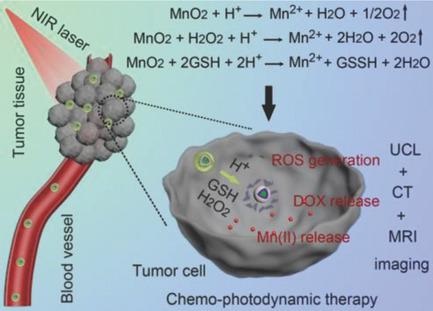当前位置:
X-MOL 学术
›
Adv. Funct. Mater.
›
论文详情
Our official English website, www.x-mol.net, welcomes your feedback! (Note: you will need to create a separate account there.)
Tumor Microenvironment‐Responsive Mesoporous MnO2‐Coated Upconversion Nanoplatform for Self‐Enhanced Tumor Theranostics
Advanced Functional Materials ( IF 18.5 ) Pub Date : 2018-07-13 , DOI: 10.1002/adfm.201803804 Jiating Xu 1 , Wei Han 1 , Piaoping Yang 1 , Tao Jia 1 , Shuming Dong 1 , Huiting Bi 1 , Arif Gulzar 1 , Dan Yang 1 , Shili Gai 1 , Fei He 1 , Jun Lin 2 , Chunxia Li 3
Advanced Functional Materials ( IF 18.5 ) Pub Date : 2018-07-13 , DOI: 10.1002/adfm.201803804 Jiating Xu 1 , Wei Han 1 , Piaoping Yang 1 , Tao Jia 1 , Shuming Dong 1 , Huiting Bi 1 , Arif Gulzar 1 , Dan Yang 1 , Shili Gai 1 , Fei He 1 , Jun Lin 2 , Chunxia Li 3
Affiliation

|
The insufficient blood flow and oxygen supply in solid tumor cause hypoxia, which leads to low sensitivity of tumorous cells and thus causing poor treatment outcome. Here, mesoporous manganese dioxide (mMnO2) with ultrasensitive biodegradability in a tumor microenvironment (TME) is grown on upconversion photodynamic nanoparticles for not only TME‐enhanced bioimaging and drug release, but also for relieving tumor hypoxia, thereby markedly improving photodynamic therapy (PDT). In this nanoplatform, mesoporous silica coated upconversion nanoparticles (UCNPs@mSiO2) with covalently loaded chlorin e6 are obtained as near‐infrared light mediated PDT agents, and then a mMnO2 shell is grown via a facile ultrasonic way. Because of its unique mesoporous structure, the obtained nanoplatform postmodified with polyethylene glycol can load the chemotherapeutic drug of doxorubicin (DOX). When used for antitumor application, the mMnO2 degrades rapidly within the TME, releasing Mn2+ ions, which couple with trimodal (upconversion luminescence, computed tomography (CT), and magnetic resonance imaging) imaging of UCNPs to perform a self‐enhanced imaging. Significantly, the degradation of mMnO2 shell brings an efficient DOX release, and relieve tumor hypoxia by simultaneously inducing decomposition of tumor endogenous H2O2 and reduction of glutathione, thus achieving a highly potent chemo‐photodynamic therapy.
中文翻译:

肿瘤微环境响应性介孔MnO2包覆的上转换纳米平台用于自我增强的肿瘤治疗学
实体瘤中的血流不足和氧气供应不足会导致缺氧,这会导致肿瘤细胞的敏感性降低,从而导致治疗效果不佳。在这种情况下,在微环境(TME)中具有超灵敏生物降解性的中孔二氧化锰(mMnO 2)生长在上转换光动力纳米粒子上,不仅用于TME增强生物成像和药物释放,还用于缓解肿瘤缺氧,从而显着改善光动力疗法(PDT) )。在该纳米平台中,获得了具有共价负载二氢卟酚e6的介孔二氧化硅涂层的上转换纳米粒子(UCNPs @ mSiO 2),作为近红外光介导的PDT试剂,然后获得了mMnO 2外壳是通过便捷的超声波方式生长的。由于其独特的介孔结构,所获得的用聚乙二醇后修饰的纳米平台可以负载阿霉素(DOX)的化疗药物。当用于抗肿瘤应用时,mMnO 2在TME中迅速降解,释放Mn 2+离子,再与UCNP的三峰(上转换发光,计算机断层扫描(CT)和磁共振成像)成像相结合,以进行自我增强成像。重要的是,mMnO 2壳的降解带来了有效的DOX释放,并通过同时诱导肿瘤内源性H 2 O 2的分解来缓解肿瘤缺氧。 并减少谷胱甘肽,从而实现了高效的化学光动力疗法。
更新日期:2018-07-13
中文翻译:

肿瘤微环境响应性介孔MnO2包覆的上转换纳米平台用于自我增强的肿瘤治疗学
实体瘤中的血流不足和氧气供应不足会导致缺氧,这会导致肿瘤细胞的敏感性降低,从而导致治疗效果不佳。在这种情况下,在微环境(TME)中具有超灵敏生物降解性的中孔二氧化锰(mMnO 2)生长在上转换光动力纳米粒子上,不仅用于TME增强生物成像和药物释放,还用于缓解肿瘤缺氧,从而显着改善光动力疗法(PDT) )。在该纳米平台中,获得了具有共价负载二氢卟酚e6的介孔二氧化硅涂层的上转换纳米粒子(UCNPs @ mSiO 2),作为近红外光介导的PDT试剂,然后获得了mMnO 2外壳是通过便捷的超声波方式生长的。由于其独特的介孔结构,所获得的用聚乙二醇后修饰的纳米平台可以负载阿霉素(DOX)的化疗药物。当用于抗肿瘤应用时,mMnO 2在TME中迅速降解,释放Mn 2+离子,再与UCNP的三峰(上转换发光,计算机断层扫描(CT)和磁共振成像)成像相结合,以进行自我增强成像。重要的是,mMnO 2壳的降解带来了有效的DOX释放,并通过同时诱导肿瘤内源性H 2 O 2的分解来缓解肿瘤缺氧。 并减少谷胱甘肽,从而实现了高效的化学光动力疗法。












































 京公网安备 11010802027423号
京公网安备 11010802027423号